Avaliação das propriedades gelificantes e emulsionantes de ...
Avaliação das propriedades gelificantes e emulsionantes de ...
Avaliação das propriedades gelificantes e emulsionantes de ...
Create successful ePaper yourself
Turn your PDF publications into a flip-book with our unique Google optimized e-Paper software.
Thus, in contrast to firmness, it seems to have no relationship between PE percentage in<br />
mixtures and adhesivity of gels.<br />
The rheological studies revealed that a gel network was rapidly formed upon heating from 20 to<br />
90 ºC, and when cooling down to 5 ºC, the gel structure was reinforced as interactions between<br />
the proteins were strengthened. Mechanical spectra obtained for gels with different mixtures<br />
showed typical patterns of weak gels. Storage modulus (G’) and loss modulus (G’’) are higher<br />
for higher concentrations of PRP which corresponds to more structured systems. Gels prepared<br />
with different mixtures showed a thermo-reversible behaviour with G´ obtained after the 2 nd<br />
heating/cooling cycle very similar to that after the 1 st heating/cooling cycle. Nevertheless, the<br />
gel prepared with 100PRP showed a typical pattern of myofibrillar protein networks with a clear<br />
thermo-reversible behaviour.<br />
Emulsions prepared with different protein mixtures at pH 7,0 and 3,8 showed high W values.<br />
The stress sweep tests of the emulsions prepared at pH 7,0 and 3,8 indicated that G´ and G´´ are<br />
stress in<strong>de</strong>pen<strong>de</strong>nt (linear viscoelasticity region) in the range of 0,5-10 Pa.<br />
The linear viscoelastic behaviour shown by the emulsions prepared with protein mixtures at pH<br />
7,0 and 3,8 is typical of protein-stabilized emulsions in which an elastic network <strong>de</strong>velops due<br />
to the occurrence of an extensive flocculation process. G´ is higher than G´´ in the frequency<br />
range studied and the evolution of G´ with increased frequency shows a ten<strong>de</strong>ncy to the<br />
<strong>de</strong>velopment of a plateau region, followed by a minimum G´´. The Plateau modulus (G 0 N) was<br />
studied as a characteristic parameter of the plateau region and has been related to the formation<br />
of a structural network in oil-in-water emulsions due to the extension of entanglements among<br />
protein molecules located at the oil-in-water interface. At pH 7,0 there was no relation between<br />
the percentage of PE and G 0 N, but at pH 3,8, a markedly increase of G 0 N with percentage of PE<br />
(0-50 %) was observed. From mechanical spectra it can be also un<strong>de</strong>rline that the shape of<br />
frequency <strong>de</strong>pen<strong>de</strong>nce of G´ and G´´ is slightly different for the emulsions studied.<br />
Steady-state flow curves, and the respective zero-shear-rate limiting viscosity, 0 , for the<br />
emulsions with different protein mixtures, were studied. For all emulsions a clear shear-thinning<br />
behaviour was noticed. The emulsion that presents a higher 0 at pH 7,0 was the emulsion<br />
prepared with the mixture 20PE+80PRP and at pH 3,8 the higher 0 was obtained with the<br />
mixture 100PRP.<br />
Another objective of this work was the <strong>de</strong>velopment of a product with the protein mixtures<br />
evaluated. Thus, 2 salad dressings with mixtures 50PE+50PRP and 20PE+80PRP were<br />
prepared with herbs and vinegar. The overall assessment of these two salad dressings was quite<br />
satisfactory. 58,3 % of the panelists preferred the salad dressing prepared with protein mixture<br />
20PE+80 PRP and 16 % the one prepared with 50PE+50 PRP.<br />
iv



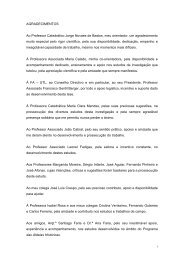

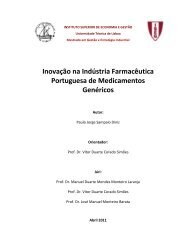
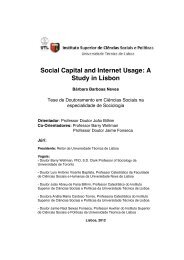
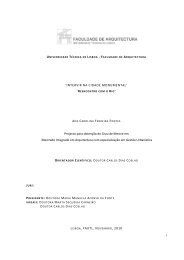
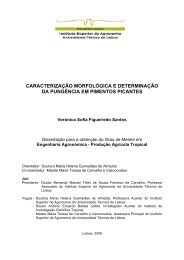

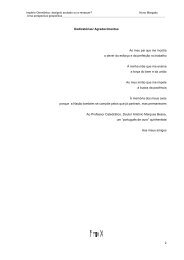
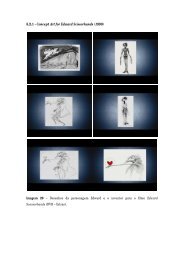
![Tese - Es..[1].pdf - UTL Repository - Universidade Técnica de Lisboa](https://img.yumpu.com/25707135/1/184x260/tese-es1pdf-utl-repository-universidade-taccnica-de-lisboa.jpg?quality=85)


